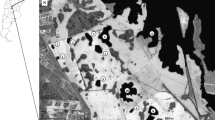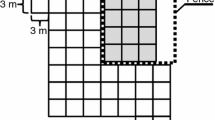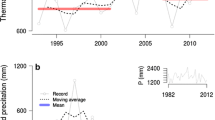Abstract
We examined herbivore damage in a natural association in order to evaluate the hypothesis that herbivory is generally greater in the shade (Maiorana 1981). Damage was measured in relation to habitat, adult plant distribution, and plant size for 13 species of native herbaceous forbs that cross the natural shade/sun ecotone at the interface of montane meadow and aspen (Populus tremuloides) woodland. Eight of the 13 species had statistically significant differences in leaf area damaged between sun and shade individuals (p<0.05). Only 3 of those were more damaged in shade (Aquilegia coerulea, Epilobium angustifolium, and Galium biflorum), while six were more damaged in the sun (Delphinium nelsoni, Helianthella quinquenervis, Lupinus argenteus, Thalictrum fendleri, and Vicia americana). No pattern was detected for 5: Erigeron speciosus, Fragaria ovalis, Lathyrus leucanthus, Viguiera multiflora, and Viola nuttallii. Levels of herbivory were species-specific rather than habitat-related. Thus, the shade habitat hypothesis must be rejected for our system, and the null hypothesis accepted for this natural assemblage. Herbivory within the shade was generally related to plant and leaf size. Two equally common community level patterns of loss occurred in relation to plant distribution. These were: 1. frequency-related, where herbivory was higher in the habitat of highest adult plant occurrence, and 2. inversely-related, where herbivory was higher in the habitat where plants were less common.
Similar content being viewed by others
References
Barrell J. 1969. Flora of the Gunnison Basin: Gunnison, Saguache and Hinsdale Counties, Colorado. Natural Lands Institute, Rockford, IL.
Berdowski J. J. M. & Zeilinga R., 1987. Transition from heathland to grassland: Damaging effects of the heather beetle. J. Ecol. 75: 159–175.
Brown V. K. 1984. Secondary succession: Insect-plant relationships. BioScience 34: 710–716.
Cates R. G. & Orians G. H. 1975. Successional status and the palatability of plants to generalized herbivores. Ecology 56: 410–418.
Coley P. D., Bryant J. P. & ChapinIII F. S. 1985. Resource availability and plant anti-herbivore defense. Science 230: 895–899.
Cottam D. A., Whittaker J. B. & Malloch A. J. C. 1986. The effects of chrysomelid beetle grazing and plant competition on the growth of Rumex obtusifolius. Oecologia 70: 452–456.
Crawley M. J. 1973. Herbivory: the dynamics of animal-plant interactions. University of California Press, Berkely.
Edwards P. J. & Wratten S. D. 1983. Ecology of insect-plant interactions. Edward Arnold Ltd, London.
Gershenzon J. 1984. Changes in the levels of plant secondary metabolites under water and nutrient stress. In: B. N. Timmermann, C. Steelink & F. A. Loewus (eds), Phytochemical adaptations to stress. pp. 273–320. Plenum Press, New York.
Handel, S. N. 1976. Population ecology of three woodland Carex species. Dissertation. Cornell University, Ithaca, New York.
Harper J. L. 1969. The role of predation in vegetation diversity. Brookhaven Symp. Biol. 22: 48–62.
Harper J. L. 1977. The population biology of plants. Academic Press, New York.
Hicks K. L. & Tahvanainen J. O. 1974. Niche differentiation by crucifer-feeding flea beetles (Coleoptera: Chrysomelidae). Amer. Midl. Nat. 91: 406–423.
Huffaker C. B. & Kennett C. E. 1959. A ten-year study of vegetational changes associated with biological control of Klamath weed. J. Range Manag. 12: 69–82.
Hughes P. R., Potter J. E. & Weinstein L. H. 1982. Effects of air pollution on plant-insect interactions: Increased susceptibility of greenhouse-grown soybeans to the Mexican Bean Beetle after plant exposure to SO2. Envir. Entomol., 11: 173–176.
Hughes P. R., Dickie A. I. & Penton M. A. 1983. Increased success of the Mexican Bean Beetle on field-grown soybeans exposed to sulfur dioxide. J. Envir. Qual., 12: 565–568.
Huntly, N. J. 1984. The influence of herbivory on plant communities: Experimental studies in a subalpine meadow ecosystem. Ph.D. Thesis, Univ. Arizona, Tucson, AZ, 200 pp.
Janzen D. H. 1974. Tropical blackwater rivers, animals and mast fruiting by the Dipterocarpaceae. Biotropica 6: 69–103.
Janzen D. H. 1975. Intra- and interhabitat variations in Guazuma ulmifolia (Sterculiaceae) seed predation by Amblycerus cistelinus (Bruchidae) in Costa Rica. Ecology 56: 1009–1013.
Joern, A. 1987. Insect herbivory in the transition to California annual grasslands: Did grasshoppers deliver the coup de grass? In: H. A. Mooney & L. A. Huenneke (eds), California annual grasslands: a model system (in press).
Langenheim J. H. 1962. Vegetation and environmental patterns in Crested Butte area, Gunnson County, Colorado. Ecol. Monogr. 32: 249–285.
Lewis A. C. 1979. Feeding preference for diseased and wilted sunflower in the grasshopper, Melanoplus differentialis. Entomol. Exper. Appl. 26: 202–207.
Lewis A. C. 1984. Plant quality and grasshopper feeding: Effects of sunflower condition on preference and performance in Melanoplus differentialis. Ecology 65: 836–843.
Louda S. M. 1982a. Limitation of the recruitment of the shrub Haplopappus squarrosus (Asteraceae) by flower- and seed-feeding insects. J. Ecol. 70: 43–53.
Louda S. M. 1982b. Distribution ecology: Variation in plant recruitment over a gradient in relation to insect seed predation. Ecol. Monogr. 52: 25–41.
Louda S. M. 1983. Seed predation and seedling mortality in the recruitment of a shrub, Haplopappus venetus Blake (Asteraceae), along a climatic gradient. Ecology 64: 511–521.
Louda S. M. 1984. Herbivore effect on stature, fruiting and leaf dynamics of a native crucifer. Ecology 65: 1379–1386.
Louda S. M. 1986. Insect herbivory in response to root-cutting and flooding stress on native crucifer under field conditions. Acta Oecol. Oecol. Gen. 7: 37–53.
Louda S. M. 1987. Insect pests and plant stress as considerations for revegetation of disturbed ecosystems. In: J. Cairns (ed.), Rehabilitating damaged ecosystems, CRC Press, Boca Raton, FL (in press).
Louda S. M., Farris M. A. & Blua M. J. 1987a. Variation in methylglucosinolate and insect damage to Cleome serrulata (Capparaceae) along a natural soil moisture gradient. J. Chem. Ecol. 13: 569–581.
Louda, S. M., Huntly, N. J. & Dixon, P. M. 1987b. Insect herbivory in response to experimentally-induced in situ plant stress: sun vs shade. Acta Oecol. Oecol. Gener: in press.
Louda S. M. & Rodman J. E. 1983a. Ecological patterns in the glucosinolate content of a native mustard, Cardamine cordifolia, in the Rocky Mountains. J. Chem. Ecol. 9: 397–422.
Louda S. M. & Rodman J. E. 1983b. Variation in glucosinolate concentration in relation to habitat and insect herbivory for the native crucifer, Cardamine cordifolia (bittercress). Biochem. Syst. Ecol. 11: 199–208.
Maiorana V. C. 1981. Herbivory in sun and shade. Biol. J. Linn. Soc. 15: 151–156.
Mattson W. J. & Haack R. A. 1987. The role of drought in outbreaks of plant-eating insects. BioScience 37: 110–118.
Osisanya E. O. 1970. Effect of shade on the rate of infestation of Triplochiton scleroxylon by Dichlidophlebia species. Entomol. Exper. Appl. 13: 125–132.
Parker M. A. & Root R. B. 1981. Insect herbivores limit habitat distribution of a native composite, Machaeranthera canescens. Ecology 62: 1390–1392.
Risch S. J. 1981. Insect herbivore abundance in tropical monocultures and polycultures: an experimental test of two hypotheses. Ecology 62: 1325–1340.
Root R. B. 1973. Organization of a plant-arthropod association in simple and diverse habitats: the fauna of collards (Brassica oleracea). Ecol. Monogr. 43: 95–124.
Siegel S. 1957. Nonparametric statistics for the behavioral sciences. McGraw-Hill, NY.
Sprague E. F. 1962. Parasitism in Pedicularis. Madroño 16: 192–200.
Van Emden H. F. (ed.) 1973. Insect/plant relationships. Blackwell, Oxford.
White T. C. R. 1969. An index to measure weather-induced stress of trees associated with outbreaks of psyllids in Australia. Ecology 50: 905–909.
White T. C. R. 1976. Weather, food and plagues of locusts. Oecologia 22: 119–134.
Whittaker J. B. 1979. Invertebrate grazing, competition and plant dynamics. In: R. M. Anderson, B. D. Burner & L. R. Taylor, (eds), Population dynamics. pp. 207–222. Blackwell, Oxford.
Author information
Authors and Affiliations
Rights and permissions
About this article
Cite this article
Louda, S.M., Dixon, P.M. & Huntly, N.J. Herbivory in sun versus shade at a natural meadow-woodland ecotone in the Rocky Mountains. Vegetatio 72, 141–149 (1987). https://doi.org/10.1007/BF00039835
Accepted:
Issue Date:
DOI: https://doi.org/10.1007/BF00039835




